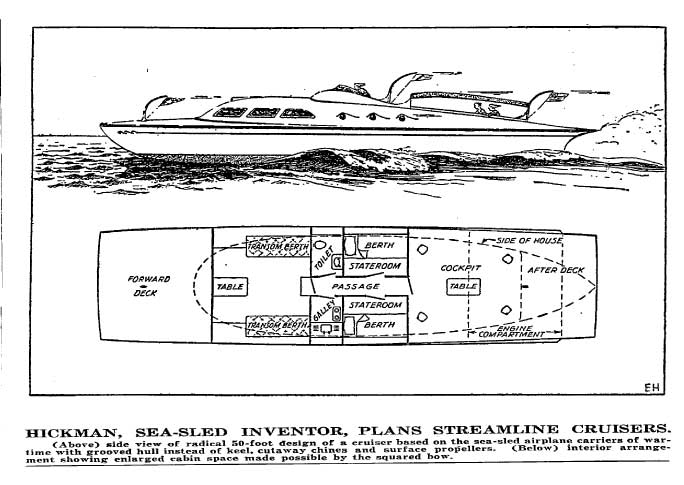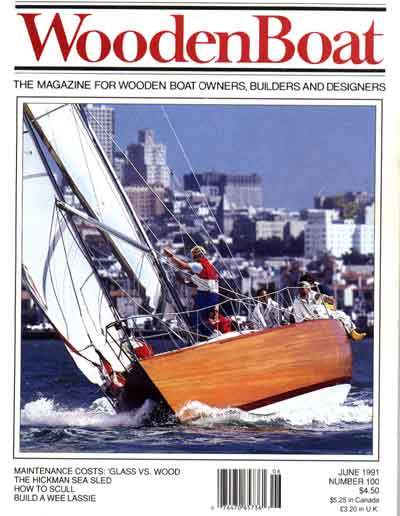


In October of 1934 Hickman recieved an order to build a 45' Sea Sled crash boat for the Navy. To help finance the endeavor he began to sell off the remaining boats of the old Sea Sled Company. He depended on this income and to help things he tried to rent space in the 1935 Boat Show.
Once again, politics were against him. Henry Sutphen, President of the National Association of Engine and Boat Manufacturers (which ran the event ) and also the President of Elco Boats (a direct competitor for naval contractors) told Hickman he could not display his boats because they were "distressed material". Hickman noted that Supthen had used the show to empty Elco's warehouses during the depression, but it was no to no avail. Sutphen was perversley obstinate and smugly told Hickman to take a hike.
Although underfinanced, Hickman immersed himself in the project, using an independent contractor to build the boat. As it had many times before, his enthusiasm clouded his judgment. Naively thinking that the Navy would be lenient because of their remembrances of his World War I rescue boats, and in an attempt to meet unusually demanding high-speed turning requirements, Hickman knowingly allowed a lot of design and construction flaws to creep into his 45-footer.
The May 1936 tests at Hampton Roads did not go well. All the problems
that Hickman had let slide came back to haunt him. The boat yawed
badly, was hard to steer, pounded, performed sluggishly, and showed
structural weaknesses. But no one could have ever said the tests
were truly fair. As a matter of record. Irwin Chase, the head
designer at Elco, was a consultant to the Trial Board. And Hickman
might have never had a chance from the start. But the overwhelmingly
poor showing of his boat was undeniable. The Trial Board's report
was devastating, and from then on the Navy never again seriously
considered a Sea Sled.
In his blind dedication to his cause, Hickman never clearly saw the writing on the wall. For the next 20 years, he persisted in trying to get the armed forces reinterested. And for the next 20 years he was constantly being beaten down in the process. His tenacity and will to overcome was as inspiring as it was tragic, but in the end it was all an exercise in futility.
ONCE AGAIN DAVID SEIDMAN GOES INTO GREAT DETAIL AT THE INCREDIBLE AMOUNT OF POLITICAL UNFAIRNESS DURING WHAT MUST HAVE BEEN A VERY FRUSTRATING & DARK TIME IN HICKMAN'S LATTER LIFE
Although it was a different world after the war, nothing seemed to have changed for Hickman. Now at the age of 68, with failing health and resources, he attacked on new fronts, doing battle in the press and trying to entice the Navy into one more try. All he managed, though, was to further alienate himself from the yachting establishment and get involved in a messy Naval contract that dragged him through the courts and drained his remaining funds. To his credit, though, he never gave up, and persisted into the mid-1950s by licensing builders to manufacture small outboard runabouts.
These little Sea Sleds caught the eye of Dick Fisher of the Fisher
Pierce Company, who, in the fall of 1955, was looking for a boat
to build with his new system of foam-cored construction. On a
blustery day in October, he and his designer, Ray Hunt, rough-water-tested
one of Hickman's 17-footers. They measured it, ran it hard, and
then approached him with a deal. Hickman's notes of that period
show that a tentative royalty agreement was reached around October
30, and that the new boats were to keep the Sea Sled name.
Apparently something went wrong after that. More than likely,
Hickman began to demand increased concessions and control. He
had protected his patents for so long it was doubtful that he
would begin to relinquish them at this point in his life. What
ever happened was enough to turn off Fisher, who then encouraged
Hunt to proceed on his own with a similar boat. Hunt took the
Sea Sled and added a center "hull" in its tunnel. His
reason of record for doing this was to eliminate cavitation; more
than likely it was also to prevent lawsuits. The finished "cathedral"
shape was revealed in 1958 as the original 13' Boston Whaler.
The rest of the story you probably already know.
Hickman never survived to see this final
insult. With eviction notices piling up in his pitifully tiny
Boston office, crushing legal fees against the Navy, and his company
in receivership, he died still fighting in the late fall of 1957.
It was a life of incredible promise and stunning flashes of genius,
all cut down to nothing for want of recognition by his peers.
Where does the fault lie? I'd say somewhere between the fears
of those who were less talented and Hickman's own self-destructive
passion for total control of his creations and unrealistic vision
of the world.
The irony, though, is that his boats were just as good as he said
they were. The new Sea Sleds being built today by Dr. Salvatore
Iannotti in Florida, designed by Johan Valentijn, are everything
that Hickman promised they could be. Fibreglass construction has
eliminated torque-generated structural problems and has allowed
for subtler modeling of the hull, Compared to a comtemporary deep-V,
a new Sea Sled makes the same speed with one-third less power,
turns in one-third the radius, is more comfortable, less sensitive
to weight, and safer at sea. They are not a panacea, just good
boats for safe, high speed at sea, which is all that Hickman ever
claimed.
With this in mind, the bravado of the quote which first brought
me to tell this story now seems lamentably poignant. And after
laying out the full scope of Hickman's life, I can't help thinking
of another quote, one which new seems infinitely more appropriate.
"It takes two to tell the truth --- one to speak, another
to hear".
For most of Albert Hickman's life, no one was listening ...David
Seidman
Thanks Captain Dave ...looking forward to future corrospondence and comparing notes on boats
